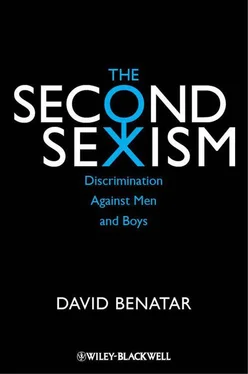The second sexism is that sexism of which males are the primary victims. As a species of sexism, it is a form of wrongful discrimination. Thus, to show that there is a second sexism, I shall have to demonstrate not only that males are disadvantaged and that at least some of this disadvantage is the result of discrimination, but also that this discrimination is wrong. I shall do this in stages. In Chapter 2, I shall present examples of male disadvantage. Some, but not all, of these disadvantages are manifestly also instances of discrimination, and often de jure discrimination. However, I shall delay until Chapter 4 the arguments that at least some of the discrimination is wrongful . In Chapter 5 I shall, among other things, ward off objections that this discrimination does not amount to wrongful sex discrimination or sexism.
If would be tedious if, on every occasion that I refer to discrimination, I were to spell out whether I meant discrimination in the pejorative or non-pejorative sense and whether I was referring to sex discrimination or discrimination on some other basis. Very often the correct sense is implicit and does not require explicit statement. Thus, while I shall often speak of unfair or wrongful discrimination, I shall often shorten this simply to “discrimination” where an adjective is unnecessary, either because it is clear from the context that I am speaking about wrongful discrimination or because I am referring to both discrimination and wrongful discrimination. Similarly, I shall not usually qualify “discrimination” with the words “sex” or “sexist” because it will usually be obvious that I am speaking about such discrimination.
This book is about the second sexism. Accordingly it is not about that sexism of which females are primary victims. This is not because I deny the existence of such sexism. It clearly exists and has existed for a very long time.
Girls and women, in some times and places, have been killed because they are female. Female infanticide is common in some of those countries with a strong preference for sons. And widows have sometimes been pressured, if not forced, to end their lives through such rituals as sati in India. Girls and women have also died through neglect. Where food is in short supply, cultures favoring sons have prioritized the feeding of boys, often allowing girls to die of malnutrition. In the developing world, women continue to die in significant numbers during childbirth. This is attributable to the absence of basic obstetric services. To some extent this is a product of their impoverished environment. However, sometimes limited services are available at some distance and insufficient priority is put on granting women access to those services. At least in such cases, the peri-partum deaths are the result of discrimination.
Millions of girls and women have had their genitals excised. Girls have regularly been deprived of education, even when boys have been provided with education. Even in many places where girls received primary and secondary education, young women were often barred from institutions of higher education. Millions of women and girls have been raped or sexually enslaved. Women have often been prohibited from owning or inheriting property and from voting and holding public office. Women are often required to cover up their bodies in ways that men are not. In the most extreme cases, a full burqa is required. Among the many restrictions imposed on women in such countries as Saudi Arabia is a prohibition on driving a car or riding a bicycle or motorcycle.
Some of these forms of discrimination are more serious than others, but none are trivial or justifiable. Their impact on the lives of women and girls should not be underestimated. However, all these forms of discrimination, as well as many others, have been widely discussed. Discrimination against females has been the subject of almost all discussion about sexism. I do not plan to add to it here. Instead I shall focus on the neglected side of sexism. My topic is the second sexism rather than the first sexism. This selectivity is not unfair. Because my aim is to show that there is a second sexism, rather than to show that there is not a first sexism, I need only cite cases of the second sexism to establish my conclusion. It is only if I were also arguing that females were not the victims of sexism that my failure to consider instances of unfair discrimination against them would be relevant.
Although I have distinguished between the first and second sexism, this distinction does not imply that they are unrelated. In the course of this book I shall point to various connections between them, while retaining my focus on the second sexism. It is worth mentioning now, however, that there are some instances of discrimination that arguably are simultaneously instances of both the first and second sexism.
Consider, for example, the United States Supreme Court case of Frontiero v. Richardson . 30 30 Frontiero v. Richardson , 411 US 677 (1973).
Sharon Frontiero, a lieutenant in the United States Air Force, had sought benefits for her husband that wives of military personnel automatically received under Federal law. By contrast, husbands of female members of the military were entitled to these benefits only if they were dependent on their wives for over half of their support. Lt. Frontiero’s request was turned down because she failed to demonstrate her husband’s dependency. A lower court ruled that the discrepant treatment did not amount to unconstitutional sex discrimination. Lt. Frontiero and her husband, Joseph Frontiero, appealed. The Supreme Court reversed the lower court’s judgment.
Although the court ruled that female service members were discriminated against by the policy of differential treatment, it is far from clear that this is exclusively a case of the first sexism. One could as easily say that husbands of female service members are discriminated against because they are denied the benefits that wives of male service members automatically enjoy. Alternatively, one could say, as I think we should, that both female service members and their male spouses are discriminated against, in which case the discriminatory policy is an example of both the first and the second sexism. It is noteworthy, however, that the court noticed only the first sexism. This supports my claim that even though a second sexism exists and is often intertwined with the first sexism, the second sexism typically remains invisible. 31 31 I am grateful to Don Hubin for drawing my attention to this case and for suggesting the observations I have made in this paragraph.
The aim of this book is to make it visible.
Arguments showing that there is a second sexism raise objections from two main directions. 32 32 There are some criticisms that do not presuppose either of the views I shall now outline. There are not many of these and I shall consider them too in due course.
Most plentiful, at least within the academy, are objections from some (but not all) feminists. From the other side come objections from some conservatives. In each case, the objectors deny either there is such a thing as the second sexism or that it is as extensive as I shall argue it is.
Consider, first, those second sexism denialists from among the ranks of feminists. Feminists, of course, are not a monolithic group. There are numerous ways of categorizing varieties of feminist, but for my purposes only one distinction is crucial. It is the distinction between those feminists who are motivated by and interested in equality of the sexes and those feminists whose primary concern is the advancement of women and girls. Some feminists — those of the second kind — are likely to claim that this is a distinction without a difference. They will argue that equality of the sexes is promoted by advancing the interests of females, and vice versa. They are (only) partly right. Promoting equality of the sexes does often coincide with the promotion of women’s interests. It does so when women are unfairly discriminated against. However, because men, as I shall argue, are sometimes the victims of unfair discrimination, the promotion of gender equality will sometimes require the advancement of men’s rather than women’s interests.
Читать дальше
Конец ознакомительного отрывка
Купить книгу












